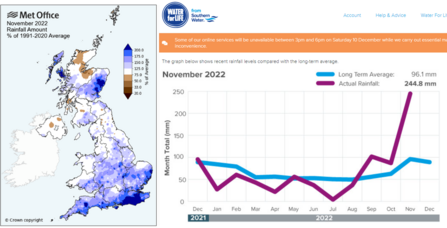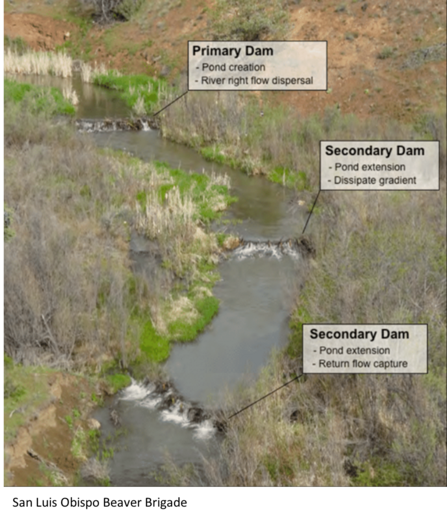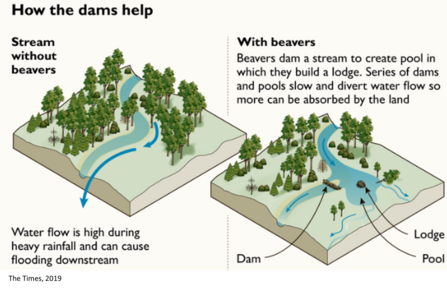2022 was quite the year for weather! Last summer we saw record-breaking temperatures and drought conditions, leading to some of the lowest river levels ever recorded (UK Centre for Ecology & Hydrology, 2022). But by November we were seeing tremendous amounts of rainfall, 28% more than average through autumn across the South of England (Met Office, 2022a), as seen in the map and graph below:
How beavers improve wetlands and reduce flooding
Beaver swimming with its head just above the water © Russell Savory
Unsurprisingly, heavy rainfall after such a dry summer led to surface water runoff as dry compacted soils struggled to absorb the deluge. Across the Isle of Wight, multiple flood alerts and a flood warning advising a risk of property inundation were issued along the Eastern Yar and Lukely Brook in November, leading to footpath, cycleway and road closures (BBC News, 2022).
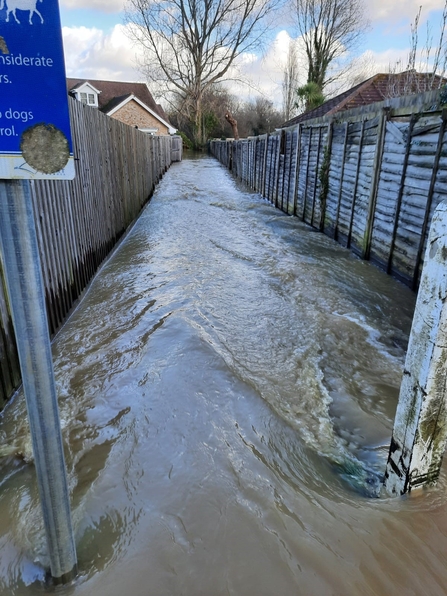
© Jamie Marsh
Hotter and drier summers followed by warmer and wetter winters are predicted to increase in frequency into the future as the climate changes, as warmer air can hold more moisture (Met Office, 2022b). Both the frequency and intensity of heavy rainfall events have been increasing when compared to rainfall events since the 1960s (Met Office, 2021), with these trends set to continue.
Climate resilience through flood prevention is therefore becoming increasingly important, and costly. The UK government announced in 2020 that the amount invested in flood and coastal erosion schemes would be doubled in England to £5.2 billion between 2021 and 2027, and in 2022 Defra set up a new ring-fenced £100 million Frequently Flooded Allowance to accelerate existing flood prevention projects and deliver new ones for eligible communities that have flooded repeatedly over the last 10 years (Defra, 2022).
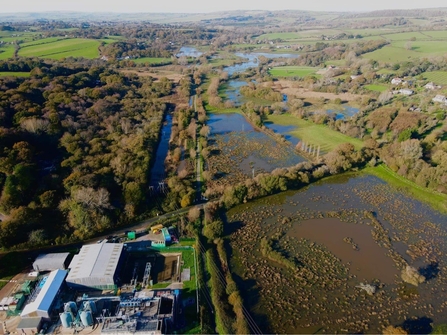
© Julian Fountaine
Natural flood management (NFM) schemes, such as river re-meandering, wetland creation and woodland planting, have become an important component of government policy recently, with £15 million of public funds invested in such schemes between 2017 and 2021 (Environment Agency, 2022). While NFM schemes were found to reduce runoff and store significant volumes of water, the need for accessible funding and the importance of maintaining NFM measures over the longer term (which generally falls upon local landowners) were found to be significant barriers to be overcome.
The recent reintroduction of beavers to the UK has also been shown to alleviate downstream flood risk, with studies carried out by University of Exeter hydrologists finding that beaver dams can increase water storage on the floodplain and slow down river flow, thereby reducing peak discharge during heavy rainfall events typically by 30% (Puttock et al., 2017). By smoothing out and lowering peak flows during heavy rainfall, beaver dams reduce the flashiness of rivers which can make downstream flows easier to manage, reducing the risk of flooding (Puttock et al., 2020).
Beaver dams help with downstream flooding in a number of ways:
Where beavers build a series of dams back to back, water in the channel is slowed down as if by a series of weirs. It takes time for the water to flow through the woody debris of the dams, meaning that pools of deep slow-moving water form upstream. The energy of the water is reduced, with a lesser volume able to pass through at any one time, meaning that downstream flow peaks are reduced. The water isn’t prevented from flowing downstream completely as the dams are leaky and permeable, but rather the water takes a longer time to flow downstream, meaning that instead of having steep flashy peaks of floodwaters, water levels downstream are more moderated and less extreme during periods of heavy rainfall.

© Izzie Tween
Or as real data taken from the Devon Beaver Project shows in this hydrograph below:
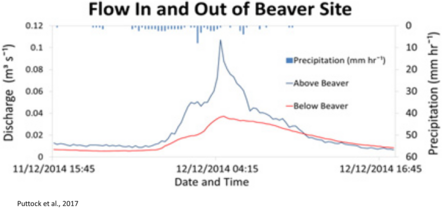
© Puttock et al., 2017
In this real life example, river flow rate downstream of 13 beaver dams in Devon was nearly three times lower than compared to upstream of the dams, buffering the impact of the deluge of heavy rainfall for communities downstream.
Another way that beavers can help slow flows and reduce flood risk is by reconnecting rivers to the floodplain, spreading water out laterally over a large area. By creating large shallow wetlands and water meadows, water travels more slowly than in a deep river channel, as there is more friction from contact with vegetation on the valley floor. As water spreads out, surrounding soils are able to absorb and store more water, leading to infiltration and percolation that can help recharge aquifers.
Not only are these wetlands great for biodiversity, but by filtering water through the dam structures themselves and surrounding soils, nutrients such as nitrates, phosphates and other pollutants can be stripped out, leading to better downstream water quality (Dewey et al., 2022).
River water can be visibly cleaner too, as seen in the image below taken at the Devon Beaver Project from both upstream and downstream of 13 beaver dams, since slower flows lead to reduced silt loads as fine particles drop out behind dams, reducing soil erosion and transport. This can benefit sensitive organisms such as insect larvae and fish, whose gills can otherwise become clogged.
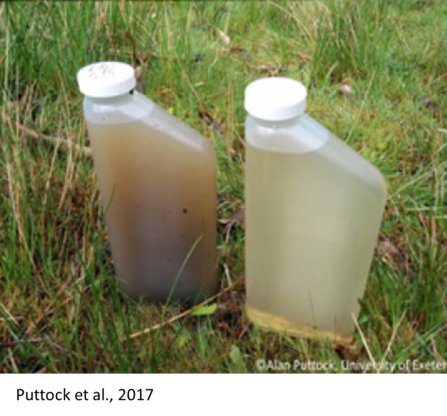
© Puttock et al., 2017
Crucially, as beavers naturally spread and recolonise England, they carry out their ecosystem engineering activities for free, with constant maintenance to create and preserve the deep ponds they feel safest in, away from the risk of predation. While management may be needed to protect valuable trees from foraging, and to prevent water levels rising behind dams on valuable land, the cost of fencing trees and dam lowering is often more affordable than largescale heavy engineering works that comprise traditional flood prevention schemes.
With a changing climate and more extreme rainfall in the forecast, beavers and their natural flood management capabilities are rapidly becoming a key part of our climate resilience strategy.
References:
-
Dewey C., Fox P., Bouskill N., Dwivedi D., Nico P. & Fendorf S. (2022) Beaver dams overshadow climate extremes in controlling riparian hydrology and water quality: Nature Communications 13: 6509
-
Puttock A., Graham H., Cunliffe A., Elliott M. & Brazier R. (2017) Eurasian beaver activity increases water storage, attenuates flow and mitigates diffuse pollution from intensively-managed grasslands: Science of the Total Environment 576 pp. 430–443
-
Puttock A., Graham H., Ashe J., Luscombe D. & Brazier R. (2020) Beaver dams attenuate flow: A multi-site study: Hydrological Processes 35 :e14017.

Free beaver keyring when you become a member!
As a member you will receive a Welcome Pack, a beautiful guide to our nature reserves, three issues a year of Wild Life magazine and information about our events programme. Follow the link below to join today and receive a free wooden beaver keyring!


